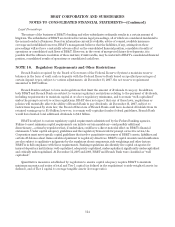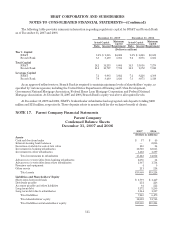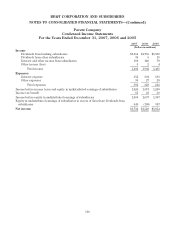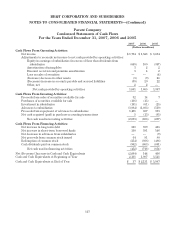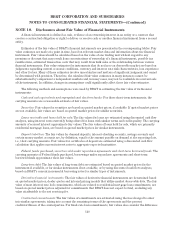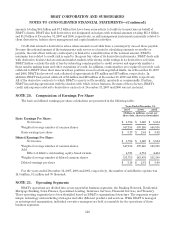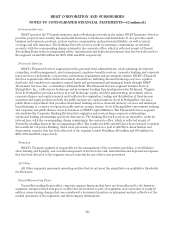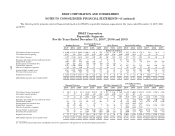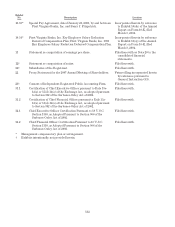BB&T 2007 Annual Report Download - page 123
Download and view the complete annual report
Please find page 123 of the 2007 BB&T annual report below. You can navigate through the pages in the report by either clicking on the pages listed below, or by using the keyword search tool below to find specific information within the annual report.BB&T CORPORATION AND SUBSIDIARIES
NOTES TO CONSOLIDATED FINANCIAL STATEMENTS—(Continued)
BB&T measures and presents information for internal reporting purposes in a variety of different ways. The
internal reporting system presently utilized by management in the planning and measuring of operating
activities, as well as the system to which most managers are held accountable, is based on organizational
structure.
Management made several changes related to its allocation methodologies for internal funds transfer pricing,
taxes, the economic provision for loan losses, the allocation of capital and certain allocations of intersegment referral
fees in 2006. These changes primarily impacted the Banking Network and Treasury segments. In some cases the
results for 2005 may not be comparable to the 2007 and 2006 results presented, because management determined that
it would be costly to reapply the new methodologies for allocating these amounts across all business segments for 2005,
with little corresponding benefit. Management believes these changes improve the financial reporting and
performance evaluation of the Company’s various business segments.
BB&T emphasizes revenue growth by focusing on client service, sales effectiveness and relationship management.
The segment results contained herein are presented based on internal management accounting policies that were
designed to support these strategic objectives. Unlike financial accounting, there is no comprehensive authoritative
body of guidance for management accounting equivalent to generally accepted accounting principles. The performance
of the segments is not comparable with BB&T’s consolidated results or with similar information presented by any
other financial institution. Additionally, because of the interrelationships of the various segments, the information
presented is not indicative of how the segments would perform if they operated as independent entities.
The management accounting process uses various estimates and allocation methodologies to measure the
performance of the operating segments. To determine financial performance for each segment, BB&T allocates
capital, funding charges and credits, an economic provision for loan and lease losses, certain noninterest expenses
and income tax provisions to each segment, as applicable. Also, to promote revenue growth and provide a basis
for employee incentives, certain revenues of Residential Mortgage Banking, Sales Finance, Specialized Lending,
Insurance Services, Financial Services and other segments are reflected in the individual segment results and
also allocated to the Banking Network. This double counting of revenue is reflected in intersegment net referral
fees and eliminated to arrive at consolidated results. Allocation methodologies are subject to periodic adjustment
as the internal management accounting system is revised and business or product lines within the segments
change. Also, because the development and application of these methodologies is a dynamic process, the financial
results presented may be periodically revised.
BB&T’s overall objective is to maximize shareholder value by optimizing return on equity and managing risk.
Allocations of capital and the economic provision for loan and lease losses are designed to address this objective.
Capital is assigned to each segment on an economic basis, using management’s assessment of the inherent risks
associated with the segment. Capital allocations are made to cover the following risk categories: credit risk, liquidity
risk, interest rate risk, option risk, basis risk, market risk and operational risk. Each segment is evaluated based on a
risk-adjusted return on capital. Capital assignments are not equivalent to regulatory capital guidelines, and the total
amount assigned to all segments typically varies from total consolidated shareholders’ equity.
The economic provision for loan and lease losses is also allocated to the relevant segments based on
management’s assessment of the segments’ risks as described above. Unlike the provision for loan and lease
losses recorded pursuant to generally accepted accounting principles, the economic provision adjusts for the
impact of expected credit losses over the effective lives of the related loans and leases. Any over or under
allocated provision for loan and lease losses is reflected in Parent/Reconciling Items to arrive at consolidated
results.
BB&T allocates expenses to the reportable segments based on various methodologies, including volume and
amount of loans and deposits and the number of full-time equivalent employees. A portion of corporate overhead
expense is not allocated, but is retained in corporate accounts and reflected as Parent/Reconciling Items in the
accompanying tables. Income taxes are allocated to the various segments based on taxable income and statutory
rates applicable to the segment.
123



